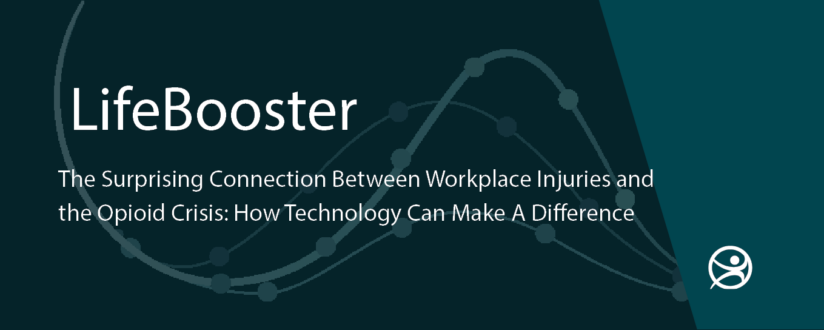
The Surprising Connection Between Workplace Injuries and the Opioid Crisis: How Technology Can Make a Difference
Introduction
The opioid crisis has had a devastating impact on countless lives across the globe. While it’s easy to assume that this epidemic is primarily driven by factors like prescription drug misuse and illicit drug addiction, there’s a surprising connection that often goes unnoticed: workplace injuries. In fact, in a study by the National Safety Council, 57% of opioid deaths in the United States involved individuals who had previously been involved in a workplace injury.
The study also found that the longer an injured worker receives opioid prescriptions, the higher their risk of addiction. If an injured worker receives an opioid prescription for more than seven days, their risk of becoming addicted doubles. If they receive a prescription for more than 30 days, their risk of addiction increases five-fold.
In this blog post, we’ll explore the link between workplace injuries and the opioid crisis, discuss how organizations can address this issue by investing in workplace safety and injury prevention, and examine the role technology, like LifeBooster’s solutions, can play in mitigating the crisis.
Workplace Injuries and the Opioid Crisis
Workplace injuries are alarmingly common, and they can happen in virtually any industry, from construction sites to office environments. According to the International Labor Organization, there are approximately 340 million occupational accidents each year worldwide. These incidents can lead to both short-term and long-term pain and disability, forcing injured workers to seek medical treatment and pain relief.
In many cases, doctors prescribe opioids as a means to manage acute and chronic pain resulting from workplace injuries. While opioids can be effective in providing short-term relief, their highly addictive nature has led to a significant increase in opioid dependence and addiction among injured workers.
A study published in JAMA Network Open found that workers with a workplace injury were 50% more likely to be prescribed opioids for pain management compared to their non-injured counterparts. Additionally, the longer an injured worker is out of work, the greater the risk of developing an opioid addiction.
The Role of Employers in Addressing the Crisis
Given the strong correlation between workplace injuries and the opioid crisis, it’s essential for employers to prioritize workplace safety and injury prevention. By implementing effective safety measures, employers can not only reduce the number of injuries but also limit workers’ exposure to the risks associated with opioid prescriptions.
Here are a few strategies employers can adopt to promote a safer work environment and help prevent the development of opioid addiction among their employees:
- Comprehensive safety training: Ensuring that employees receive thorough safety training is crucial to reducing the risk of workplace accidents. This includes providing information on potential hazards, proper use of equipment and machinery, and best practices for injury prevention.
- Regular hazard assessments: Employers should conduct periodic assessments of the workplace to identify and address potential hazards. This can include ergonomic evaluations, safety audits, and assessments of work processes to identify areas of improvement.
- Early intervention and support: In the event of a workplace injury, employers should prioritize early intervention and provide employees with access to appropriate medical care and rehabilitation services. This can help reduce the need for long-term opioid use and decrease the risk of addiction.
- Alternative pain management options: Encourage healthcare providers to consider non-opioid pain management options whenever possible. This can include physical therapy, over-the-counter pain relievers, and other non-pharmacological approaches to pain management.
- Employee assistance programs: Offer access to employee assistance programs (EAPs) that provide support for employees struggling with opioid addiction. EAPs can connect workers with resources such as counseling, treatment programs, and support groups.
The Role of Technology in Reducing Opioid Addiction Cases
Advanced technologies, like those developed by LifeBooster, can play a significant role in reducing the number of workplace injuries and, consequently, opioid addiction cases. LifeBooster’s mission is to ensure that every worker gets home safely every day, and the company’s innovative solutions are designed to make that a reality.
LifeBooster’s wearable multi-point sensors and risk analytics platform, Senz™, enable organizations to capture data related to worker movements and identify areas with the highest risk for musculoskeletal disorders (MSDs) and heat stress. By providing a granular level of detail, LifeBooster’s technology helps organizations prioritize and implement programs and processes that have an immediate impact on worker safety.
With the help of technology like LifeBooster’s, employers can:
- Identify high-risk tasks and processes: By analyzing data collected from wearable sensors, organizations can pinpoint the tasks and processes that pose the greatest risk for injuries, and take targeted actions to reduce those risks.
- Implement proactive safety measures: LifeBooster’s technology allows organizations to act proactively by providing insights on where to invest and prioritize efforts before injuries happen. This can help prevent workplace injuries and the subsequent need for pain management through opioids.
- Continuously improve workplace safety: LifeBooster’s solutions enable organizations to adopt a continuous improvement model, where assessments are performed iteratively to ensure that implemented measures are effective in reducing risks.
Conclusion
The opioid crisis is a complex and multifaceted issue with far-reaching consequences. By understanding the connection between workplace injuries and opioid addiction, and harnessing the power of technology like LifeBooster’s solutions, employers can play a critical role in addressing this crisis. By prioritizing workplace safety, providing early intervention and support, and utilizing innovative technologies to prevent injuries, organizations can help reduce the risk of opioid addiction among their workforce and contribute to the overall fight against this devastating epidemic.
Curious to learn how you can leverage technology to understand the impact of heat stress? Contact us:
